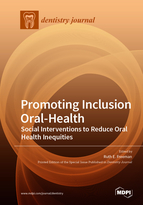Promoting Inclusion Oral-Health: Social Interventions to Reduce Oral Health Inequities
A special issue of Dentistry Journal (ISSN 2304-6767).
Deadline for manuscript submissions: closed (30 November 2018) | Viewed by 27737
Special Issue Editor
Interests: dental anxiety in children and adults; inclusion oral health; oral health services for excluded groups; intensive psychotherapeutic intervention; dental staff well-being and communication.
Special Issues, Collections and Topics in MDPI journals
Special Issue Information
Dear Colleagues,
The aim of this collection of papers is to provide the reader with a cogent understanding of the role of evidence in the development of social or community-based interventions to promote inclusion oral-health and reduce oral health, health, and psychosocial inequities. In addition, this material will include various methods used for their implementation and evaluation.
At the outset, the reader will be offered a working definition of inclusion oral-health, which will be modelled on the work of Luchenski et al. [1]. The interventions described are theoretically underpinned by a pluralistic definition of evidence-based practice [2] and the radical discourse of health promotion as postulated by Laverack and Labonte [3] and others [4,5]. This Special Issue will consist of eight papers, including an introduction. The first three papers will examine the various sources of evidence used to transform top-down into bottom-up community-based interventions for people experiencing homelessness; people in custody and for families residing in areas of high social deprivation. The final four papers will report on the implementation and evaluation of social or community-based interventions. This collection of research papers will highlight the importance of focusing on prevention and the adoption of a common risk factor agenda to tackle oral health, health and psychosocial inequities felt by those most excluded in our societies.
References:
- Luchenski S.; Psych, N.M.D.; Aldridge, R.W.; Hayward, A.; Story, A.; Perri, P.; Withers, J.; Clint, S.; Fitzpatrick, S.; Hewett, N. What works in inclusion health: Overview of effective interventions for marginalised and excluded populations. The Lancet. 2018, 391, 266–280. DOI:https://doi.org/10.1016/S0140-6736(17)31959-1
- Holmes D.; Murray, S.J.; Perron, A.; Rail, G. Deconstructing the evidence-based discourse in health sciences: Truth, power and fascism. Int. J. Evid. Based Health. 2006, 4, 180–186
- Laverack G.; Labonte R. A planning framework for community empowerment goals within health promotion. Health Policy Plan, 2000, 15, 255–256.
- Freeman R. Health promotion and the randomised controlled trial: a square peg in a round hole? BMC Oral Health 2009, doi:10.1186/1472-6831-9-1
- Freire P. Pedagogy of the Oppressed. The Continuum International Publishing Group Inc.: London, UK, 1996.
Prof. Ruth E. Freeman
Guest Editor
Manuscript Submission Information
Manuscripts should be submitted online at www.mdpi.com by registering and logging in to this website. Once you are registered, click here to go to the submission form. Manuscripts can be submitted until the deadline. All submissions that pass pre-check are peer-reviewed. Accepted papers will be published continuously in the journal (as soon as accepted) and will be listed together on the special issue website. Research articles, review articles as well as short communications are invited. For planned papers, a title and short abstract (about 100 words) can be sent to the Editorial Office for announcement on this website.
Submitted manuscripts should not have been published previously, nor be under consideration for publication elsewhere (except conference proceedings papers). All manuscripts are thoroughly refereed through a single-blind peer-review process. A guide for authors and other relevant information for submission of manuscripts is available on the Instructions for Authors page. Dentistry Journal is an international peer-reviewed open access monthly journal published by MDPI.
Please visit the Instructions for Authors page before submitting a manuscript. The Article Processing Charge (APC) for publication in this open access journal is 2000 CHF (Swiss Francs). Submitted papers should be well formatted and use good English. Authors may use MDPI's English editing service prior to publication or during author revisions.







